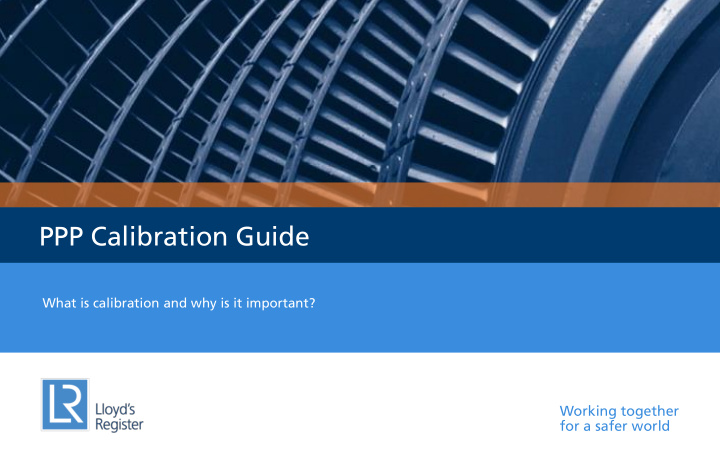



PPP Calibration Guide What is calibration and why is it important? Working together for a safer world
Calibration - purpose • To improve the fairness and consistency of how PPP ratings are approached across LR • Brings manager peer groups together to discuss the performance of their people and consider provisional ratings (how they intend to rate individuals) • Allows multiple opinions/perspectives to be considered (with the view that good open debate provides a more accurate and fair assessment) • Typically happens between May – July in advance of holding 1:1 PPP reviews in July
Preparing for a Calibration meeting Before a calibration meeting, all managers must: Consider the examples/evidence of each team member’s performance over the year to • date Decide on an overall ‘provisional’ rating for both goals and BCs for each team member • (pending their input) This must be based on the two key factors of performance: • What have they achieved? (To what extent have they met their goals?) How have they behaved? (To what extent have they displayed the BCs?) The manager must also be prepared to provide evidence-based feedback on their • peers’ direct reports
The Calibration meeting Attend ndee ees The chairperson (normally Head of Function or Team) • Peer group of managers • HR where available to facilitate • How it it works Each manager presents provisional ratings of their team members on the PPP • Calibration Matrix Their peers are invited to provide additional constructive feedback • Any changes to provisional ratings are recorded • Requ quire ired outcome tcome All managers have validated their provisional ratings for each team member •
Roles and responsibilities in the Calibration meeting The Chairperson (Generally the Group’s Line Manager) Scheduling the meeting • Chairing the meeting • Providing constructive and impartial feedback on individuals they have observed • Deciding the final ‘provisional ‘rating in the event of disagreement • The Manager ager Providing the provisional ratings of their direct reports and evidence for those ratings • Recording the agreed provisi sion onal al rating ng given • Providing feedback/evidence on any other individuals who they have worked with but don’t • report into them HR HR Facilitating the discussion and promoting fairness and consistency • Working with the Chairperson to collate the provisional ratings •
Preparing for a Calibration meeting Most managers will have multiple direct • reports This PPP Calibration Matrix helps to capture • the names and provisional ratings of all colleagues being discussed. Names can be entered into the matrix using • the text boxes to represent their provisional PPP rating . The facilitator of the session, typically HR, will • more likely populate this after gathering provisional ratings in advance of the session
Facilitating a Calibration meeting (The chairperson / HR) Agend nda • Introduce the purpose of the session and the process • Establish the ground rules for: • Providing evidence and feedback • How to challenge ratings • Resolving disagreements • Undertake the calibration • Populate all the ratings onto the PPP Matrix
Various options for calibrating groups of individuals Calibration meetings can be conducted in several ways, so be clear from the start which you will use: Cali libra brate te everyone yone (suitable for smaller teams) • Cali libra brate te by exception eption (focus on those individuals where the group • disagrees on the suggested ratings – suitable for larger teams) Calibrate ‘Extremes’ only (focus on those individuals at the corners or • edges of the PPP matrix - suitable for larger teams) All ratings discussed during calibration must be treated as confidential
Challenging & Achieving Consensus Makin ing deci cision sions Differing views should be supported by objective evidence • If a decision cannot be agreed by the group, the Chairperson is • responsible for deciding the final ‘provisional’ rating How to Challe lleng nge Can you give me an example of how he/she has demonstrated the BCs • at the level above? What were your reasons for placing that individual there? • Thank you for your example. I have seen the opposite behaviour to • what you’ve described. Provide example….. Remember mber to use the goal al measures ures or BC indi dicators tors when n providing viding evidence dence or challeng allenging ng someone one on how they have rated
How to calibrate - an example This is a typical example of how a calibration meeting might be conducted: Senior The senior leader is chairing the calibration Leader meeting… The managers are Manager Manager Manager participating in the calibration meeting… The team members’ Team Team Team ratings are being discussed and calibrated
Post Calibration – End of Year PPP reviews Once calibration is complete the manager can hold the End of Year PPP meetings • Managers and individuals will discuss what they think the overall goal rating and • overall BC rating should be (e.g. 3:3) The manager should remain open minded – the rating agreed at calibration may • change if the individual highlights significant new examples If the final rating is different to the one discussed at calibration the manager • should inform the ‘Group’ manager The discussions and ratings should then be recorded in Success Factors – individuals • at Step 5 and managers at Step 6 The manager will then push the form to Step 7 for individuals to ‘FINALISE AND • CLOSE’ .
Recommend
More recommend